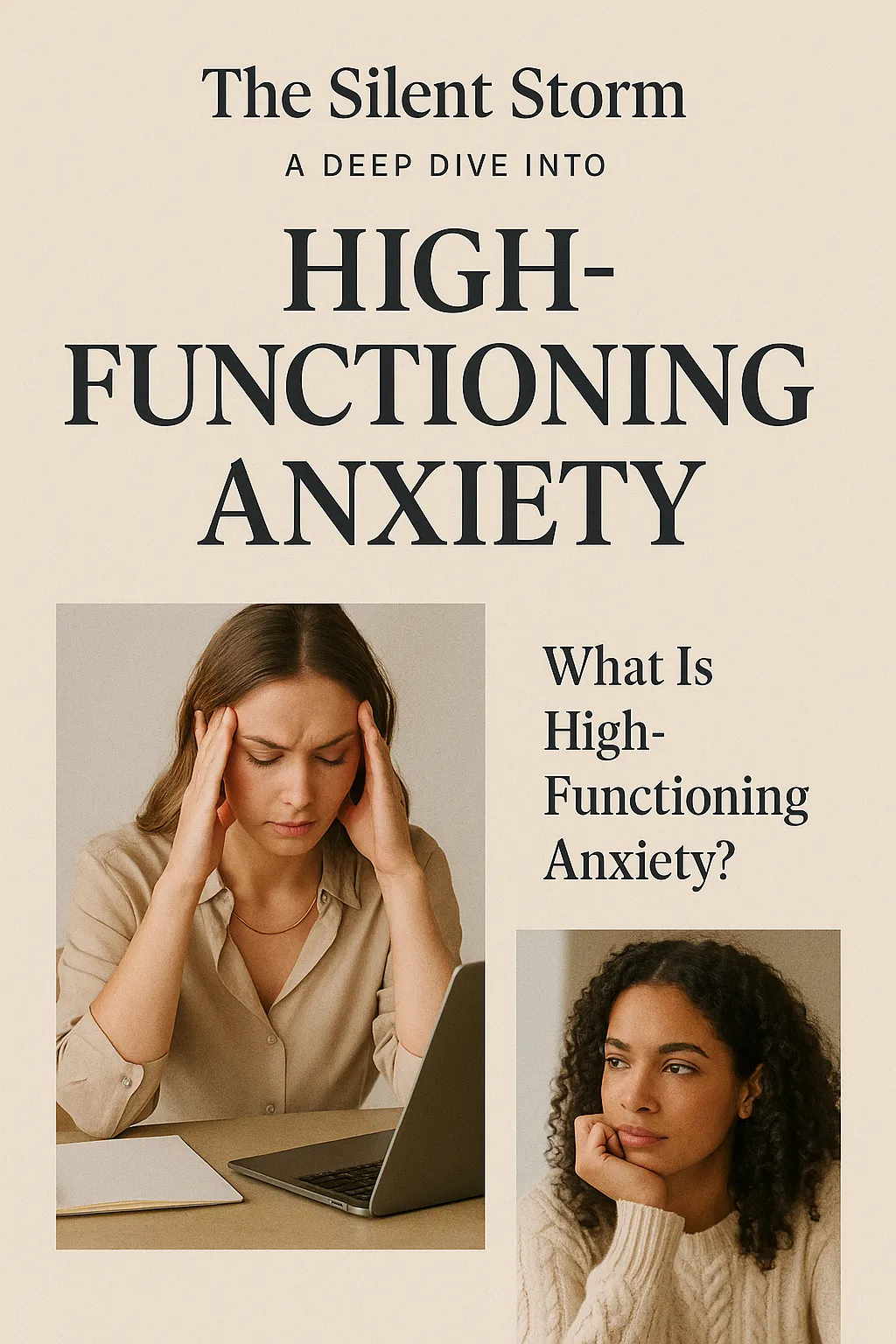
The Silent Storm: A Deep Dive Into High-Functioning Anxiety
In every group chat, there’s usually someone who has it together.
They remember birthdays, juggle work deadlines with grace, show up to support others, and still find time to reply to texts with emojis and punctuation. They’re composed. Reliable. Productive.
But what you don’t see is the undercurrent of pressure that drives it all.
Inside, they’re overthinking every conversation, battling perfectionism, and constantly fearing they’re falling short. The calm exterior is a performance; the backstage is chaos.
This is high-functioning anxiety—an often invisible and deeply misunderstood experience.
What Is High-Functioning Anxiety?
High-functioning anxiety isn’t a clinical diagnosis in the DSM-5, but it’s a lived reality for many. It describes a type of anxiety where the person appears successful or “put together” on the outside, but is internally driven by fear, worry, and self-doubt.
Unlike generalized anxiety, panic disorder, or social anxiety—which might disrupt someone’s ability to work, socialize, or perform daily tasks—high-functioning anxiety coexists with achievement. The anxiety fuels performance.
It’s easy to miss because society tends to reward anxious behaviors when they look like productivity.
The Telltale Signs (That Are Easy to Dismiss)
People with high-functioning anxiety may not even realize they’re anxious. They may just see themselves as “driven,” “ambitious,” or “detail-oriented.” But here are some common internal experiences:
• You never feel like you’ve done enough, no matter how much you accomplish.
• You’re always on, always planning the next task, mentally rehearsing what might go wrong.
• You struggle with sleep, either due to racing thoughts or the need to stay productive.
• You overthink everything—what you said, how you said it, whether someone’s mad at you.
• You say yes out of fear—fear of disappointing someone, missing out, or being judged.
• You equate your worth with your output—rest feels undeserved.
• You appear calm, but inside there’s a constant hum of tension.
What makes high-functioning anxiety so insidious is that people often don’t seek help. They’re praised for their work ethic, not asked how they’re really doing.
Behind the Mask of Competence
Beneath the achievements is a nervous system in high alert. The constant pressure to keep up, to stay ahead, to never let your guard down—it’s not sustainable.
Over time, high-functioning anxiety can lead to:
• Burnout: Emotional and physical exhaustion, cynicism, and a sense of reduced accomplishment.
• Chronic stress symptoms: Tension headaches, digestive issues, fatigue, and insomnia.
• Emotional numbness: Difficulty accessing joy, calm, or genuine rest.
• Strained relationships: Overcommitting and people-pleasing can lead to resentment or disconnection.
It’s not that people with high-functioning anxiety don’t want to slow down. It’s that slowing down feels dangerous. Rest triggers the fear of losing control, of becoming irrelevant, of being “lazy.”
Why This Happens: The Psychological Roots
High-functioning anxiety doesn’t appear out of nowhere. It often stems from a complex interplay of:
• Childhood experiences: Growing up in unpredictable or achievement-focused environments can teach us that love and safety must be earned.
• Perfectionism: A fear of failure and a belief that mistakes are unacceptable.
• Societal pressure: Hustle culture, comparison, and social media can normalize burnout and glorify overachievement.
• Trauma: Anxiety can be a survival response—your nervous system staying alert because it once needed to.
The mind learns to associate being “on top of things” with safety. But it’s not peace—it’s vigilance.
What Healing Can Look Like
Recovery from high-functioning anxiety doesn’t mean you lose your drive or stop caring. It means you learn to uncouple self-worth from performance. You begin to value your inner world as much as your outer accomplishments.
Here’s where healing often begins:
1. Recognizing the Pattern- Acknowledge that what looks like “success” may be built on stress. Name the anxiety. Awareness softens shame.
2. Learning to Pause- Start practicing micro-moments of rest. One deep breath. Ten minutes of not being productive. Train your nervous system to tolerate stillness.
3. Therapy- Therapeutic approaches like Cognitive Behavioral Therapy (CBT), somatic work, or Internal Family Systems (IFS) can help rewire anxious beliefs and soothe the internal critic.
4. Setting Boundaries- Saying no, limiting commitments, and protecting rest time is not selfish—it’s survival.
5. Redefining Success- Ask: Who am I without the achievements? What would it mean to be enough, even when I’m doing nothing?
You Deserve to Breathe
High-functioning anxiety convinces you that your worth is in your utility. That people only love the version of you who delivers, performs, and never drops the ball.
But you are more than your to-do list. You are allowed to be messy, tired, quiet, imperfect—and still worthy.
You are allowed to stop holding everything together.
Sometimes, peace looks like doing less. Sometimes, healing begins the moment you stop trying to prove anything.
If this feels familiar…
You’re not alone. And you don’t need to go through it quietly. Speak to someone. Slow down, even just a little. You’re not lazy for resting. You’re not weak for feeling overwhelmed.
You’re human. And you deserve gentleness, too.
